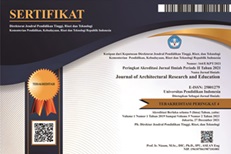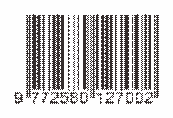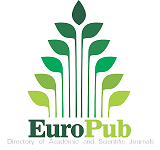Redefining Order in Urban Areas: A Case Study of the Morphology of Medan and Palembang Cities
Abstract
Keywords
Full Text:
PDFReferences
Adiyanto, J., Nugroho, S., & Atyanta, A. (2020). Analysis of Urban Form and Infrastructure in Palembang. ATRIUM Jurnal Arsitektur, 4(1), 1–9. https://doi.org/10.21460/atrium.v4i1.26
Arefi, Mahyar. “Order in Informal Settlements: A Case Study of Pinar, Istanbul.” Built Environment (1978-), vol. 37, no. 1, 2011, pp. 42–56. JSTOR, www.jstor.org/stable/23289770. Accessed 21 Apr. 2021.
Fahri, M., Harsritanto, B. I. R., & Rahmadyani, H. (2023). Kajian Elemen Fisik Kota Palembang berdasarkan Analisis Persepsi dan Unsur Elemen Pembentuk. Jurnal Teknik, 21(1), 43–57. https://doi.org/10.37031/jt.v21i1.341
Kropf, K. (2018). The Handbook Of Urban Morphology. Chichester, UK: John Wiley & Sons Ltd.
MacAdoo, W., Bittner, E., Werthman, C., & Blauner, R. (2017). Order and Disorder in the City. The American City: A Sourcebook of Urban Imagery, 10(2), 267–293. https://doi.org/10.4324/9781315130934-10
Meliana, S., Rombe, O. S. C., Henry, L., Fajarwati, A. A. S., & Rachmayanti, I. (2021). A Comparison Review of Kevin Lynch’s Urban Theory with the Chinese Cosmography of Feng Shui in the Heritage Area, Case Study: Pasar Baru, Jakarta. IOP Conference Series: Earth and Environmental Science, 933(1). https://doi.org/10.1088/1755-1315/933/1/012039
Pafka, E., Dovey, K., & Aschwanden, G. D. P. A. (2020). Limits of Space Syntax for Urban Design: Axiality, Scale, and Sinuosity. Environment and Planning B: Urban Analytics and City Science, 47(3), 508–522. https://doi.org/10.1177/2399808318786512
Pangaribuan, M. E. (2022). Kebijakan Rencana Tata Ruang Wilayah Dalam Pembangunan Rumah Toko Di Kota Medan (Studi Kasus Badan Perencanaan Pembangunan Daerah). Jurnal Ruang Luar Dan Dalam, 3(1), 42–51.
Profil Kota Medan 2015-2019
Profil Kota Palembang 2015-2019
Putra, S. M., Latief, R., & Suaeb, I. (2022). Pengaruh Perubahan Morfologi Kota Terhadap Pembentukan Struktur Ruang Kota Kupang. Urban and Regional Studies Journal, 4(2), 102–109. https://doi.org/10.35965/ursj.v4i2.1465
Rashid, M. (2017). The Geometry of Urban Layouts. 10.1007/978-3-319-30750-3.
Romdhoni, M. F. (2020). Analisa Kepadatan Kota, Pergerakan dan Perkembangan Morfologi Kota Palembang, Indonesia. Arsir, 4(2), 25. https://doi.org/10.32502/arsir.v4i2.2771
Romdhoni, M. F., & Rashid, M. (2021). URBAN GEOMETRY: CITY SHAPE AND SPATIAL LAYOUT OF 6 INDONESIAN GOVERNMENT CENTERS. DIMENSI (Journal of Architecture and Built Environment), 47(2), 71–86. https://doi.org/10.9744/dimensi.47.2.71-86
Sianturi, A. R., Andari, S., Simanjuntak, P. A., & ... (2024). Dinamika Perkembangan Tata Ruang Kota Medan: Analisis Penggunaan Lahan Dan Dampaknya Terhadap Keberlanjutan Kota. Jurnal Intelek Insan …, 560–564. https://jicnusantara.com/index.php/jiic/article/view/489
Sujiyati Maryani, A. N. H. (2008). Pembangunan Kota Palembang dengan… │ 1. 1–34.
Utama, M., & Idris, A. (n.d.). Optimalisasi Perencanaan Tata Ruang Daerah Pinggiran Kota Palembang yang Berkelanjutan. 254–273. https://doi.org/10.24843/JMHU.2025.v14.i0
Utami, L., Priatna, S. J., & Purnama, D. H. (2017). Identifikasi dan Evaluasi Kawasan Ruang Terbuka Hijau (RTH) Berdasarkan Kondisi Sifat Tanah di Wilayah Kota Palembang Provinsi Sumatera Selatan. Jurnal Penelitian Sains, 19(3), 112–118.
Veronica, S., & Siregar, R. W. (n.d.). KAWASAN ( Studi Kasus : Jl . Brigjen Katamso-Jl. Avros-Jl. Karya Jaya-Jl . A . H .
Von Meiss, Pierre. “Order and Disorder.” Ekistics, vol. 55, no. 333, 1988, pp. 295–299. JSTOR, www.jstor.org/stable/43620648. Accessed 21 Apr. 2
Yuniar, E., Salamah, A. N., Dyah Kania, V., Lestari, V. T., Arsitektur, J., Sipil, T., & Perencanaan, D. (2019). Desain Ruang Terbuka Publik Ditinjau dari Elemen Pembentuk Fisik Kota. Jurnal Arsitektur TERRACOTTA |, I(1), 45–56.
Zhu, X., Wang, X., Yan, D., Liu, Z., & Zhou, Y. (2019). Analysis of the influence of remotely sensed ecological indexes on the dynamic urban thermal environment using an integrated ecological index: a case study of Xi’an, China. International Journal of Remote Sensing, 40(9), 3421–3447. https://doi.org/10.1080/01431161.2018.1547448
DOI: https://doi.org/10.17509/jare.v7i2.86033
Refbacks
- There are currently no refbacks.
Copyright (c) 2025 Journal of Architectural Research and Education

This work is licensed under a Creative Commons Attribution-NonCommercial-ShareAlike 4.0 International License.

This work is licensed under a Creative Commons Attribution-ShareAlike 4.0 International License.








